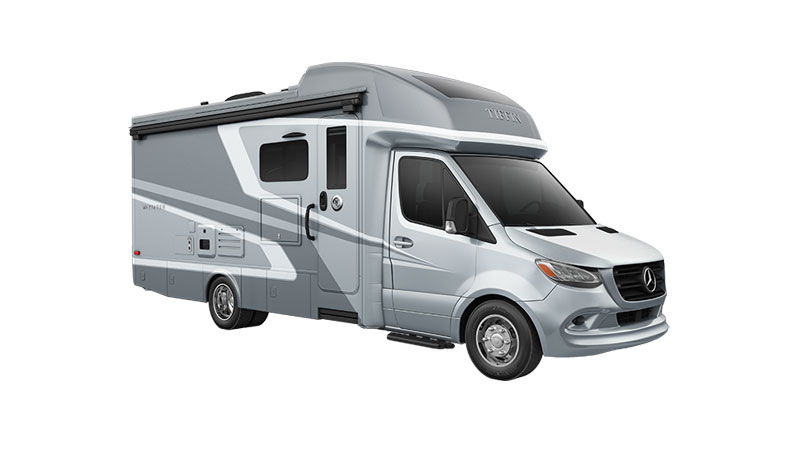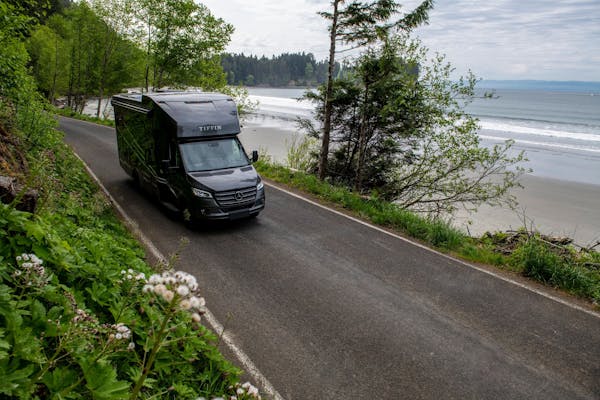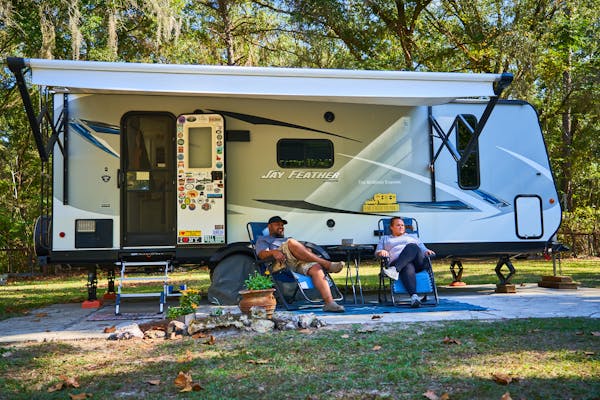There's a unique allure to the open road, a sense of adventure that beckons from the horizon. For those of us who've answered the call, Recreational Vehicles (RVs) serve as our trusty steeds, carrying us towards the promise of new experiences. But, as with any epic journey, it's crucial to put safety first. Your RV is not just your transport, but your home on wheels. Ensuring its well-being ensures yours, too.
Understanding your vehicle's strengths and limitations forms the foundation of a safe and enjoyable adventure. So, buckle up, Class C RV enthusiasts, as we embark on a comprehensive journey into the world of safe RVing.
Understanding Class C RV:
Size, functionality and basics
Class C RVs are the “swiss army knife” of motorized RVs, offering a balance of comfort and maneuverability. Typically built on a van, truck, or a semi chassis (big super C’s), these beauties come with all the amenities of home. But don't let their cozy interiors fool you; they are larger than your average vehicle and require specialized handling.
Size matters in RVing, and with Class C RVs generally ranging from 20 to 40 feet, understanding their dimensions is vital. It informs everything from choosing the right campsite to safely navigating city streets and highways. A Class C RV's functionality lies in its clever use of space, with sleeping, cooking, and bathroom facilities neatly tucked into its design. However, this compact living can also lead to heavier loads, which impact driving dynamics.
Creating a Height and Length Reminder on Dash: An Essential Safety Tip
In the world of RVing, forgetting your vehicle's dimensions can lead to disastrous consequences. That's why creating a height and length reminder on your dash is an essential safety tip.
This constant visual reminder can save you from scrapes with low bridges or tight turns. It's also a handy reference when planning your route or selecting a campsite. So, grab a sticky note or a piece of tape, and jot down those vital measurements. Ours also says, “Watch out for trees.” That may sound obvious, but it is easy to get comfortable and to cover your basics. We certainly have in our Tiffin Wayfarer because its vantage point is similar to a van that we own that is actually much shorter.
Carwash and Building Heights Awareness: Protecting Your Investment
Awareness of your RV’s height is crucial. Many new RVers learn the hard way when their vehicles encounter bridges, carwashes, gas station covers, or building overhangs that are too low. A good rule of thumb is always to know the height of your RV and double-check clearance levels before proceeding.
We always do a lot of research and read car wash reviews before we head out to find a local one on trips. Be careful as some people's “huge bays” might not be huge/tall enough for your RV. If you can’t find enough info, take the time and call around. We prefer outdoor truck bays whenever possible so roof height isn’t an issue, but you must still be cautious as the boom heights can differ and even still be too short.
When it comes to fueling up, not all gas stations are created equally. We prefer to find truck stops whenever possible, but if they aren’t available we resort to reviews and websites to research gas stations in the area.
Planning Ahead: An Essential Part of Safe RVing
As Benjamin Franklin famously said, "By failing to prepare, you are preparing to fail." This wisdom holds especially true for safe RVing. Planning ahead is more than just plotting your route on a map; it involves considering factors like weather conditions and road quality. Even National Park and campsite regulations need to be considered since many have length restrictions. This was a primary reason we chose our 25-foot long Tiffin Wayfarer.
A well-planned journey allows you to anticipate challenges and make necessary adjustments. Knowing the height of your RV can save you from the unpleasant surprise of low bridges or overhangs. For example, the popular tourist area around Mount Rushmore and Crazy Horse monuments has tunnels on Iron Mountain Road and are not tall enough to accommodate an average sized Class C RV. Knowing any height limitations ahead of time can save you a ton of trouble down the road.
PREPARING FOR THE ROAD
Benefits of Practicing RV Driving: Familiarity and Confidence
Think back to when you first learned to drive. It was probably a little intimidating, right? Now imagine the same scenario, but with a vehicle that's potentially three times the size of a typical car. It's enough to make anyone anxious. That's why practice is key when it comes to driving an RV.
The more time you spend behind the wheel, the more familiar you become with your vehicle's size and handling. This familiarity breeds confidence, making you a safer and more competent driver. Practice in a variety of conditions, including night driving, city traffic, and different weather conditions. We recommend starting close to home. Try driving to your local grocery store or through familiar back roads first. This takes off the added pressure of navigating to somewhere new while you’re getting comfortable behind the wheel.
Importance and Benefits of RV Driving Courses
Despite your experience with regular vehicles, an RV is different. If you desire some extra piece of mind, an RV driving course can provide valuable insights into handling your vehicle safely.
These courses cover everything from basic maneuvers to advanced techniques like parking and reversing. They also cover essential safety checks and maintenance procedures. Plus, completing a course can mean reduced insurance premiums, making it a win-win situation.
The Value of Taking an RV Safety Course
We've already touched on the importance of RV driving courses, but it's worth emphasizing the value of a dedicated RV safety course. These courses cover aspects of RVing that go beyond driving, including fire safety, propane handling, and even first aid.
These courses often include practical exercises, allowing you to put your newfound knowledge into action. So, if you're serious about safe RVing, consider signing up for an RV safety course. It's an investment in peace of mind.
The Importance of Using RV Specific GPS
We all rely on GPS to guide us to our destinations. But did you know that there's a GPS specifically designed for RVs? An RV-specific GPS takes into account the specific requirements of these vehicles, including height, weight, and length restrictions.
These specialized devices can warn you of low bridges, narrow roads, and height-restricted tunnels. They can also guide you to RV-friendly routes and campsites. So, when planning your RV adventure, consider investing in an RV-specific GPS. It's like having a seasoned RVing expert right there on your dashboard.
ON THE ROAD
The Advantage of Two Drivers: Ensuring Rested and Alert RV Operation
Long drives can be exhilarating, but they can also be exhausting. Fatigue is a significant contributor to road accidents. This is where having two drivers comes in handy. Alternating between drivers ensures that each person gets adequate rest, keeping both alert and responsive to road conditions. Driving an RV requires more concentration than driving a standard car due to its size and weight. A rested driver is more likely to make sound decisions in challenging situations, contributing to overall safety. Besides, having two drivers also means having twice the fun, with each getting to enjoy the scenery while the other focuses on the road.
Additionally, a second driver is beneficial in case of a medical emergency or adventure injury, they can assist getting the group and RV home or to safety.
The Importance of Driving Slowly with an RV
In an RV, slower is safer. The larger the size and weight of your RV, the longer it will take to stop or slow down. Driving at a slower speed allows more time to react to changing road conditions or unexpected obstacles. It can also reduce the risk of rollovers and accidents. High speeds can make an RV more susceptible to crosswinds and can lead to loss of control.
Understanding the Need for Extra Space Between Vehicles
Remember your first driving lesson when your instructor emphasized the importance of maintaining a safe following distance? This rule is even more critical when driving an RV. Due to their size and weight, RVs need a greater stopping distance than regular cars.
Maintaining extra space between vehicles gives you more time to react, reducing the risk of collision. It also provides a safety buffer in case of sudden stops or changes in traffic flow. So, when you're out there on the road, remember, distance is your friend.
Why No U-Turns: Understanding RV Movement and Maneuverability
Driving an RV isn't like driving a compact car. The size and weight of these vehicles affect their maneuverability, making some movements more challenging than others. One such move is the U-turn. While it might be a convenient way to reverse direction in a car, it can be a risky maneuver in an RV, especially for a new RVer.
Because of their length, RVs require a wider turning radius. Attempting a U-turn on a narrow road can lead to your RV blocking both lanes, potentially causing accidents. Instead, consider finding a safe place to turn around, like a parking lot or wide intersection. That’s why we believe it is best that you avoid u-turns all together, or wait till you have a lot of experience in your unit before you attempt this maneuver.
Why Rearview Cameras are helpful for Safe RVing
Just as a rearview mirror is essential for a car driver, a rearview camera is a must for safe RVing. Given their size, RVs have larger blind spots, making reversing or changing lanes more challenging. A rearview camera provides a clear view of what's behind you, reducing the risk of accidents. While ours has this as a standard option, that’s not always the case. We highly recommend purchasing one as an aftermarket purchase if your vehicle does not come equipped with one.
These cameras come in particularly handy when parking, allowing you to spot obstacles that might be missed by side mirrors. Some models even provide night vision, making it safer to navigate in low light conditions. So, when it comes to safe RVing, consider a rearview camera as your third eye.
Stop and Navigate: A Strategy for Uncertain Situations
Even the most experienced RVers encounter uncertain situations on the road. Whether it's a sudden road closure or an unexpected detour, these moments can test your navigation and coping skills. In these situations, the best strategy is to stop, then navigate.
Pull over safely, take a deep breath, and assess the situation. Consult your maps, check your GPS for alternate routes, or even ask a local for directions. Remember, it's better to lose a little time figuring out your route than to barrel ahead into potential danger. Safe RVing is all about patience, planning, and a little bit of problem-solving.
PARKING & CAMPSITES
The Role of Partners in Parking: A Key to Safe RVing
Navigating into tight parking spots or reversing into a campsite can be a challenge even for experienced drivers. This is where having a partner can be invaluable.
A parking partner can guide you from outside the vehicle, providing a second pair of eyes to spot potential obstacles. This can prevent damage to your RV and ensure the safety of others around you.
Bonus Tip: Many RVers use walkie talkies to be able to easily communicate with their parking partner from inside the RV. A good pair of walkie talkies can really come in handy while on the road!
Choosing A Campsite for a Class C
Whether you're looking for a secluded spot in the mountains or a bustling campground near the beach, there are countless campsite options to choose from. When searching for a campsite for a class C RV, it's important to check the length of the site to ensure that it can accommodate your vehicle.
Some RVers prefer a pull through site when starting their RV journey. This avoids unnecessary back up parking. Additionally, it's important to consider the accessibility of the campsite. Sometimes it is best to call the campground ahead of your arrival to check for any obstacles like low-hanging trees, as some campsites may have narrow roads or other obstacles coming in and out. By carefully considering these factors, you can find the perfect campsite that offers both beauty and convenience.
MAINTENANCE CHECKS
The Importance of Regular Safety/Maintenance Checks
Being safety conscious means staying vigilant about the condition of your RV. Regular maintenance checks help prevent unwanted surprises on the road. Just like your car needs regular servicing to stay in top condition, so does your RV. These checks should include all systems – from your engine to your electrical system, from your tires/brakes to your propane system.
Remember, an RV is more than just a vehicle; it's your home while on the road. It’s crucial to keep in mind the weight of your RV and pack lightly to stay within OEM recommended load capacity (GCWR), for both your safety, life of the unit, and fuel efficiency. Plus, being aware of your vehicle's weight helps you navigate steep gradients safely. Safe cargo capacity and regular maintenance helps ensure that all systems are functioning correctly, providing a safe and comfortable living environment. So, make regular safety/maintenance checks part of your RVing routine.
Conclusion: Embrace Safe RVing for a Rewarding Adventure Experience
RVing offers an unparalleled sense of freedom and adventure. But, like any great journey, it comes with its share of challenges. By embracing a safety-first mindset, planning ahead, and continually learning, you can navigate these challenges confidently.
Remember, safe RVing isn't just about following rules or ticking off a checklist. It's about creating a mindset of safety that guides every decision you make on the road. With this guide, you're well on your way to mastering the art of safe RVing. So, here's to many rewarding adventures ahead, and remember, keep safety first!







